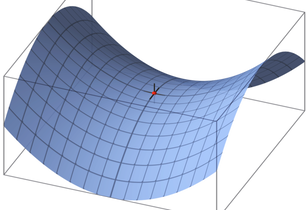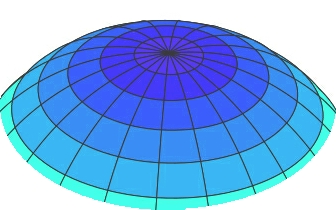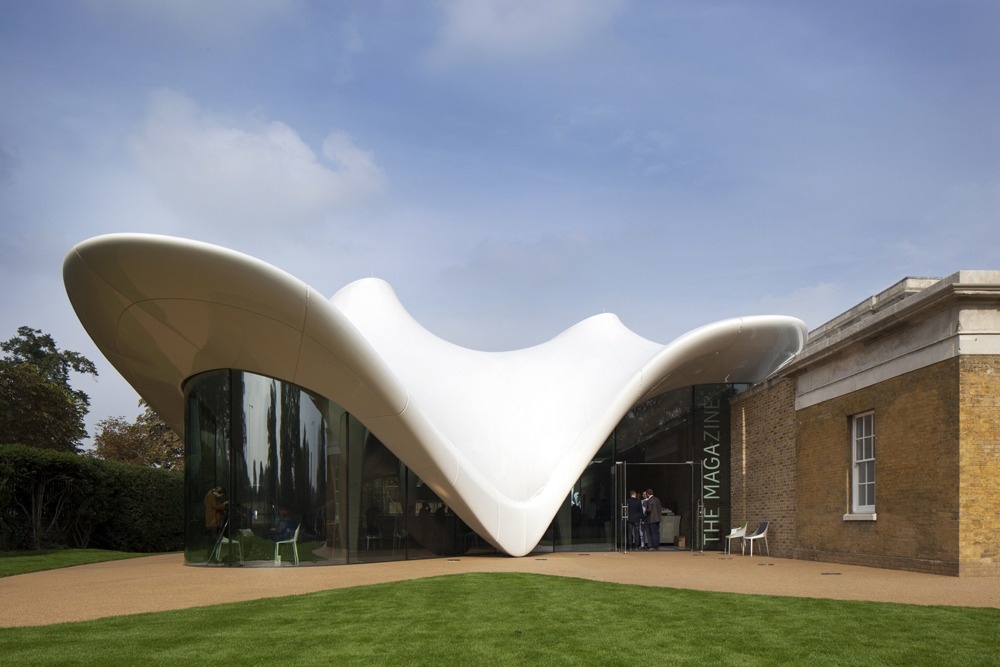Anticlastic structures
Tensile surfaces, that is, surfaces which carry only tension and no compression or bending, rely on double curvature for their stability. Stability is provided by the opposition of two curvatures which enable the surface to be tensioned without losing its form.
Tensioning the surface reduces its elasticity and so its tendency to deform under load, and the curvature itself means that the surface will deform less for any given extension.
Tensile surfaces can be used in buildings to create thin, long span enclosures, such as roofs for sports stadia, shopping centres, atria and so on. Typically they are constructed using a PVC coated polyester or PTFE coated glass fabric, typically just 1 mm thick.
Double curvature can be anticlastic or synclastic.

|

|
| Anticlastic (saddle-shaped). | Synclastic (dome-shaped) |
Anticlastic surfaces are those in which the centres of curvature are located on opposing sides of the surface. This is commonly-described as a saddle shape. A hyperbolic paraboloid is an anticlastic surface.
Synclastic surfaces are those in which the centres or curvature are on the same side of the surface. This is a dome-shape. This can be created with an architectural fabric by inflation – that is, air pressure within the dome maintains the form of the surface when it is tensioned, rather than the opposition of the curvatures.
[edit] Find out more
[edit] Related articles on Designing Buildings Wiki
- Barrel vault.
- Biaxial bending.
- Concept structural design of buildings.
- Conoid shell.
- Fabric structures.
- Hyperbolic paraboloid.
- Limit state design.
- Millennium Dome.
- Structural engineer.
- Synclastic.
- Tensegrity.
- Tensile structures.
- The development of structural membranes.
- The structural behaviour of architectural fabric structures.
- Types of dome.
[edit] External references
- ‘How structures work: Design and behavior from bridges to buildings’ (2nd ed.), YEOMANS, D., Wiley (2016)
Featured articles and news
Latest Build UK Building Safety Regime explainer published
Key elements in one short, now updated document.
UKGBC launch the UK Climate Resilience Roadmap
First guidance of its kind on direct climate impacts for the built environment and how it can adapt.
CLC Health, Safety and Wellbeing Strategy 2025
Launched by the Minister for Industry to look at fatalities on site, improving mental health and other issues.
One of the most impressive Victorian architects. Book review.
Common Assessment Standard now with building safety
New CAS update now includes mandatory building safety questions.
RTPI leader to become new CIOB Chief Executive Officer
Dr Victoria Hills MRTPI, FICE to take over after Caroline Gumble’s departure.
Social and affordable housing, a long term plan for delivery
The “Delivering a Decade of Renewal for Social and Affordable Housing” strategy sets out future path.
A change to adoptive architecture
Effects of global weather warming on architectural detailing, material choice and human interaction.
The proposed publicly owned and backed subsidiary of Homes England, to facilitate new homes.
How big is the problem and what can we do to mitigate the effects?
Overheating guidance and tools for building designers
A number of cool guides to help with the heat.
The UK's Modern Industrial Strategy: A 10 year plan
Previous consultation criticism, current key elements and general support with some persisting reservations.
Building Safety Regulator reforms
New roles, new staff and a new fast track service pave the way for a single construction regulator.
Architectural Technologist CPDs and Communications
CIAT CPD… and how you can do it!
Cooling centres and cool spaces
Managing extreme heat in cities by directing the public to places for heat stress relief and water sources.
Winter gardens: A brief history and warm variations
Extending the season with glass in different forms and terms.
Restoring Great Yarmouth's Winter Gardens
Transforming one of the least sustainable constructions imaginable.























